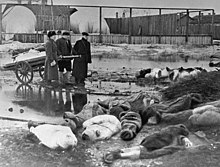Today marks the 75th anniversary of the start of the Siege of Leningrad. On September 8, 1941, German and Finnish troops cut off the last land access to Leningrad, in a move deliberately designed to starve the residents. The city was cut off almost completely until January 18, 1943. For most of that time, the only lifeline was a route over Lake Ladoga known as both the “Road of Life” and the “Road of Death.”

Nevetsky Prospekt, Leningrad, 1942. Wikipedia photo.
During the siege, approximately 1.5 million Soviets died, mostly of starvation. Most residents subsisted on 125 grams (about a quarter pound) of bread per day, and the bread consisted of half sawdust.
One propaganda coup scored by the Soviets was the premiere of Symphony No. 7 by Dmitri Shostakovich. It was composed by Shostakovich partially while in the sieged city, and partly after being evacuated. But it had its premiere on the Leningrad radio on August 9, 1942. The date was highly symbolic, since it had been scheduled by Hitler as the date for a celebration within the city of the completion of the invasion. Supposedly, Hitler even had invitations printed up for the event to be held at the Leningrad Astoria Hotel.
The first rehearsal lasted but 15 minutes, since the musicians (especially the brass players) were physical unable to perform due to malnutrition. But with heroic efforts, the concert took place as scheduled, and was broadcast.
For full propaganda effect, loudspeakers outside the city were directed toward the German lines, and the German soldiers were treated to the concert. One German soldier later recalled, “who are we bombing? We will never be able to take Leningrad because the people here are selfless.”

Civilians constructing anti-tank fortifications. Library of Congress photo.
While the concert was broadcast over “radio,” the actual broadcast almost certainly took place not over the airwaves, but through the extensive Soviet wired broadcasting network. The vast majority of “radio” receivers in the Soviet Union were not actual radio sets, but a speaker, transformer, switch, and volume control, which may or may not have been mounted in a radio cabinet. The receiver was commonly called a “rekord.” These simple receivers were connected to a wired network, similar to a telephone network, which would carry the program continuously. Indeed, according to this source, private radio receivers were confiscated at the very beginning of hostilities with Germany.
Immediately prior to the war, the Soviet Union boasted over 5.5 million wired speakers. In contrast, as of 1936, the country had only 650,000 radio receivers, 270,000 of which were crystal sets. A nice collection of such speakers (mostly postwar) can be found at this link.
The use of wired radio during the siege of Leningrad is stated here:
The wire net of the radio diffusion exchange may carry programs which originate at the exchange, and this makes possible utilization of the radio for mass communication of a purely local nature. This ability to broadcast without actually going “on the air” proved itself invaluable during the war, since the local radio could continue to function and maintain contact between the authorities and the population without the risk of having enemy aviators make use of the signals to guide them to their objective.
An outstanding example of such use of the wired net is to be found in the siege of Leningrad. During the siege the Leningrad wired net operated around the clock. During hours when no programs were on and throughout the night the Leningraders kept their speakers tuned in. The slow beat of a metronome kept the wire alive. Whenever it was necessary to make an important announcement the beat of the met – ronome was rapidly increased. Thus, at all times the authorities were able to maintain constant contact with the population, to transmit orders, warn of danger, or make special announcements .
Communications Research 1948-1949, page 245.
The Seventh Symphony was first broadcast in the United States on July 9, 1942, over the NBC network. As explained in an article in the April 1945 issue of Radio Age, the musical score was sent from Moscow to the United States via facsimile, or what the article called radiophoto.
At Amazon
Click Here For Today’s Ripley’s Believe It Or Not Cartoon
![]()

